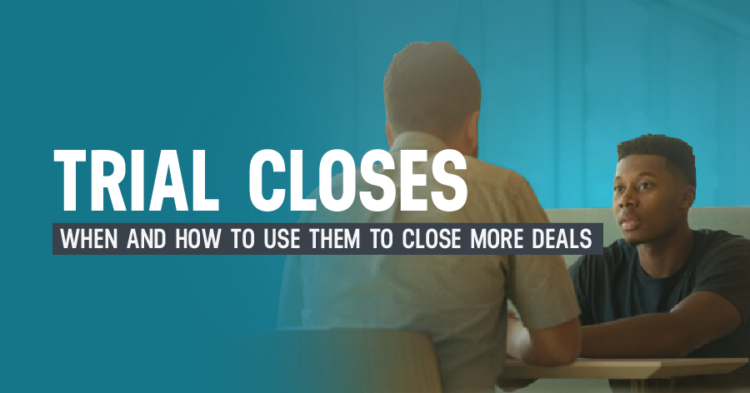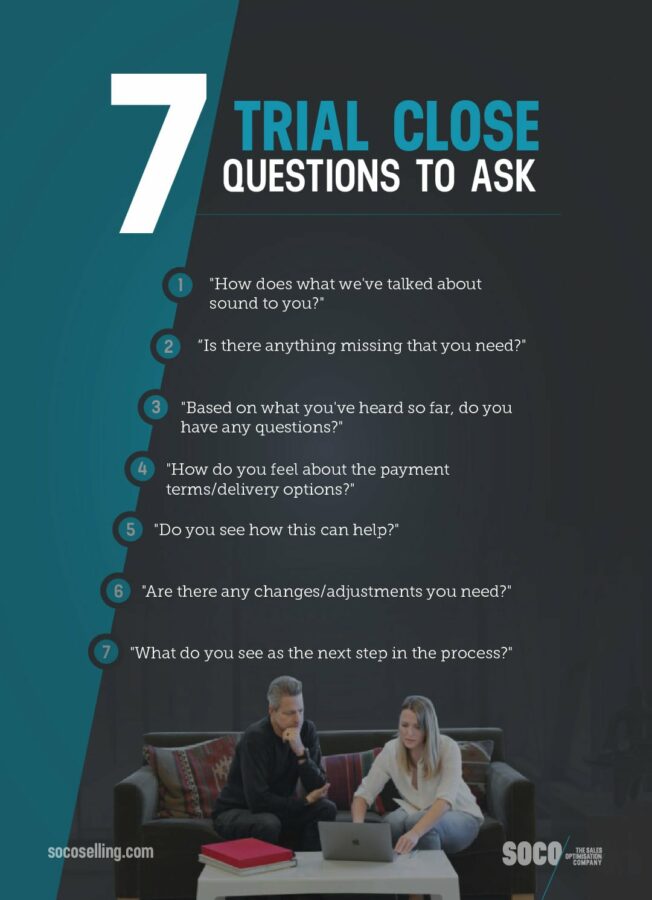
Whenever we ask our audience what the most crucial aspect of sales is, they typically echo, “Always be closing!” While this isn’t a bad sentiment to remember, it isn’t ideal, especially if you’re prone to being timid when asking for the sale. The good news is there is a better way to ensure you get the deal you want without resorting to sleazy sales tactics. So it’s time to forget the outdated mantra popularised by the 1992 movie Glengarry Glen Ross and instead replace it with “Always be trial closing!”. Read on now to discover how to master the art of trial closes and increase your close rate whilst strengthening the attraction of your offering.
What is a Trial Close?
A trial close is an alternate method sales professionals use to determine whether customers are ready to buy and, thus, close the deal. While traditional closing techniques depend on asking a customer to decide on their purchase, a trial close asks them to share their opinion or perspective on the offering – enabling you to address their needs. Ultimately, the purpose of a trial close is, as the name suggests – to examine the likelihood of the buyer purchasing by testing their interest.
What’s the difference between trial closes and asking for the sale?
Whilst asking for the sale and trial closes are similar in that you’re attempting to attain a sale; they’re not the same thing. Asking for the sale is essentially a hard close, whereas a trial close is a process of asking for incremental commitments to gauge how likely a prospect is to buy. For instance:
Asking for the sale (Hard Close):
- “Are you ready to get started?”
- “We have three of these left. Would you like to proceed with 1 now?”
- “All I need now is a 50% deposit and we can get started right away, does that sound good?”
Trial close examples:
- Based on what you’ve heard so far, do you have any questions?
- How does what we’ve discussed sound to you?
- Is there anything missing that you need?
Also read: 15 Top Sales Closing Techniques To Increase Close Rates
What are the benefits of a Trial Close?
Whilst trial closes are a great way to gauge your prospect’s interest and help determine whether they’re ready to buy without coming across as pushy – they have more than one benefit. Here’s what you could be missing out on by not using trial closes:
Uncover obstacles
We’ve all been there. You may have spent days or weeks putting the time, sweat, and tears into explaining to a customer why your offering is ideal for solving their problem, only for them to tell you that they can’t make a purchasing decision.
Not only does this queue a bunch of internal screaming, but it’s an entirely avoidable obstacle you could’ve avoided if you had used a trial close earlier.
Trial closes are a perfect opportunity to ask questions that uncover problems, for instance: “Do we have everything we need to move forward?”
When you ask questions like this, you’ll likely find out if you have multiple key stakeholders to deal with. Or if the person sitting in front of you can even sign off on the deal.
Also read:
- How to Ask For The Sale Without Being Pushy
- 5 Reasons Why You Aren’t Closing The Sale
- Sales Roadmap – Stay Focused on Closing the Sale
Discover opportunities
The obstacles we discussed aren’t roadblocks; they’re opportunities you’re now aware of, but only if you handle the confirmation correctly. For instance, a great place to start, if you’re unsure, is to ask them the magic wand question:
“If you had a magic wand and could change anything about [proposal/offering], what would you change?”
The idea is that you don’t want them to change a thing! In other words, for them to be satisfied with your offering. If not – you still have some work to do.
Understand customers feelings
It’s often difficult to determine how a customer feels at any given time during your sales activities. This is why trial closes benefit you from achieving this without being obvious.
What’s more, if customers feel they can open up to you and share their perspectives and opinions. You’ll be far more likely to develop a trust-based relationship, meaning closing that deal will be easier.
Determine a sales timeline
Trial closes allow the salesperson to gauge their exact location in the sales process, enabling you to formulate the remainder of your approach for maximum success.
For example, if your customer is nodding eagerly and agreeing to every statement you make, go for the close.
If they’re not receptive to your questions, cage their answers. You know you need to backtrack, slow down and identify their needs.
Optimize your approach
Armed with the information you’ve gathered from asking open-ended questions. You can now personalize your sales strategy to meet your buyer’s needs -making them far more likely to buy from you.
How to Master the Art of Trial Closes
While still largely dependent on your industry, customers, and product or services, your trial close may follow a slightly altered process for someone else. With that said, there is a basic framework that all salespeople should implement if they want to master the art of trial closes. Check out the five steps below to start using trial closes as a regular fixture in your sales approach:
1. Review their Behavior
The first crucial step of mastering the art of trial closes begins with identifying your customer’s behavior to decide which open-ended question they will best respond to. Subsequently, this will give you the best angle to prove your solution is perfect for their challenge. At this stage, you should be reviewing their body language, their responses, and what aspect they’ve taken the most interest in (price, features, quality, timing, and so on)
2. Ask open-ended questions | Trial close questions
After reviewing their behavior for possible starting points, you can decide which open-ended question will most effectively gauge their interest in purchasing your product or service. For example, use these trial closes to get a sense of where your customers are at, and it will help you address potential roadblocks and objections while they’re small before they get bigger:
- How does what we’ve discussed sound to you?
- Is there anything missing that you need?
- Based on what you’ve heard so far, do you have any questions?
- How do you feel about the payment terms/delivery options?
- Do you see how this can help?
- Are there any changes or adjustments needed?
- What do you see as the next step in the process?
Learn more from How to Ask For The Sale Without Being Pushy

3. Identify their perspective
Your customer will likely respond in varying ways to your questions, and you have to be ready to respond regardless of whether they ask a question themselves, share their opinion, or make an outright objection. Moreover, you need to use these interactions to conclude their current perspective and where they are on your sales timeline. For example, suppose they state they need multiple deliveries a week. In that case, you need to quickly formulate an attractive response about how you can deliver fast and in large quantities – but don’t ever lie about what you can provide!
4. Handle sales objections
Are you an objection handler or a hater? If you plan to incorporate the trial close into your sales process, you’ll need to be ready to answer any objections you uncover by asking open-ended questions. To quickly summarise, a sales objection is a clear expression by a prospective buyer that they’re not yet satisfied enough to want to buy from you, meaning that you have more work to do to remove the barrier that’s stopping them from being happy.
To prepare yourself for objections ahead of time, spend some time listing the common objections people have given you in the past and create a short rationale for why each objection is not valid. Then, practice saying them out loud so you’ll feel confident when prospects raise objections. In fact, role-playing is the best way to experience the feelings that accompany closing and responding to objections, so be sure to practice with a colleague or alone with a video recorder.
You can also get a head start by reading our in-depth guide to handling sales objections here: The Ultimate Guide To Objection Handling.
5. Pivot your strategy
Now you know precisely what your customers need, you can optimize your offering to suit them. However, be careful to assess the genuine interest of your customer; if they’re willing to answer questions about their needs but aren’t fully invested and are giving noncommittal answers – they’re probably not close to being ready to buy. In comparison, if they’re nodding away and smiling – you know you can start moving towards a hard close.
6. Go for the final close
Now that you’ve done the trial closes:
- What do you think?
- How does that sound?
- Is there anything missing?
Now it’s time to transition from those trial closes or soft closes to things that are a little more forceful. Asking questions like: What would you like to do next? That’s a close. This is where you start to take ownership of your sales pipeline. It’s not up to your customer to fill your pipeline and help you hit your commission. That’s your job. There’s an old saying that goes like this: “If you go through your whole presentation and demonstration but fail to ask for the sale, and then they go to another company, and that person closes that deal, all you’ve done is you warmed them up for the next salesperson.”
So, while it’s important to use trial closes, you also need to make sure that when the time is right, you outright ask for the sale.
Trial close best practices | Always be trial closing
Attempting your first trial close can be daunting, primarily if you still rely heavily on traditional sales closing methods. That’s why we’ve provided you with helpful best practices you can use before, during, and after the trial close to ensure you’re on track: The Ultimate Guide To Objection Handling
Understand customer needs
So many salespeople go into a meeting ready to pitch a solution, and seemingly, it’s as though it doesn’t matter what the customer wants or needs. They already have a product or service in mind that they want to sell. While we all have quotas, targets, and KPIs to meet, we also have to focus on what’s important to the customer.
Struggling with this aspect? Read 10 Sales Needs Analysis Questions You Should Always Ask Prospects to formulate your sales needs analysis immediately.
Recognize buying signals
Buying Signals can be verbal or non-verbal signals that your prospective customer will give you as an indication that they might be ready to buy. Now, this is not an exact science, not always true, and not always confirmed, but if they are ready to buy, your job is to ask questions to discover what is holding them back.
Common buying signal examples
- Nodding: If you notice that your prospect is nodding while you’re speaking to them, that’s usually a good indicator that they’re interested and that they’re responding positively to what you’re saying.
- Leaning forward: If they’re leaning forward, that means they’re interested, engaged, and want to know more.
- Smiling: A universal symbol for “I like you, and I like this.”
- Asking questions: Questions mean that they’re interested and want to know more. They may even be considering how your solution could fit in their environment.
- Making positive statements: This is obvious, isn’t it? But when your prospect says things like, “Wow, neat. Cool. That’s interesting!” those are perfect signs they’re ready to buy.
Practice active-listening
Listen carefully to what is most important to your customer before you start throwing in discounts. The more you listen, the more you understand what’s truly important to your customer. You might find that it’s more than just price. There could be some other concerns or things that are important to them beyond price – either way, it’s up to you to listen and find out.
Ask for incremental commitments
Rather than do one pitch meeting or a presentation and say, “Sign here,” you need to get your prospect to make small incremental commitments. A commitment would be an obligation or a promise, so an incremental commitment would be small, bite-sized pieces or portions. For example, you could ask your prospects to commit to:
- Meeting with you.
- Reading your proposal.
- Introducing you to a decision-maker.
- Scheduling a conference call with key stakeholders.
- Forwarding a survey to their staff to understand their needs before you propose something.
What you’re looking to do is gain a small commitment – something they can agree to do now that’s relatively easy. The idea is that by getting your customers to commit to small things and to follow through on those small things, you’re one step closer to closing those big deals.
Maximize your sales skills in only 12 weeks with personalized 1-1 coaching
You’re good at what you do, but know that there’s a next level.
That’s where our 12-week intensive Sales Mastery program comes in.
Our individual sales coaching program involves a tailored learning system consisting of e-learning, six 1-on-1 coaching sessions and email support.
We call it ‘intensive’ because it is – during the 12 weeks, you’ll be working on your sales skills, gathering and documenting your sales process, crafting new scripts and perfecting your craft.


